#marsilio sourcing
Explore tagged Tumblr posts
Text
Meandering Thoughts on Marsilio and Giovanni and Marriage Contracts
In 1453 Lusanna di Benedetto and Giovanni della Casa burst into the legal record through a marriage trial – it was held in ecclesiastical courts rather than secular, a rarity at the time as marriage was predominantly a secular rite in late medieval and early modern Florence. The Church was only secondary to what was understood to be an inherently earthly arbitration between families.
Lusanna and Giovanni’s case was simple: were they truly married or was Lusanna a concubine? Naturally, Lusanna said she was a wife, Giovanni allowed her to be a concubine at best. The implication of what he truly thought left hanging in textual silence.
The problem for Lusanna proving that she was Giovanni’s wife lay in the documentation, or not, of their marriage. The entire ordeal did not follow the expected, and in some respects prescribed, route that a marriage ought to follow.
Traditionally, a marriage must be documented from the initial betrothal agreement through to the marriage contract and the delivery of the dowry. All of this was to be carefully documented by a notary for the honour and security of both families involved. Florence, in many respects, lived and died by documents. By knowledge creation, textual representation of actions taken or not taken.
Which was important, since Florentines perceived marriage as a fraught space for legal chaos – in the legal documents around marriage there is language speaking to arbitration, owing, contractual obligations, payments owed for reneging &c. and it was all done in a way quite distinct from their northern contemporaries.
For Lusanna – she had no betrothal contract, no marriage contract, and no dowry delivered to Giovanni. There were witnesses: her brothers and the friar who married them – but no one from the groom’s side. More pressing was that there was no public procession of the bride leaving her natal home to cross the city to her husband’s home. There was no stately, public announcement of the intention to set up a household. While they did sort-of live together in a husband-wife manner, the extent of it did not pass the bar of expectation.
All of this is because Giovanni wished to keep their marriage a secret from his family due to the great misalliance between him and Lusanna.
Lusanna was a widow above the traditional marriageable age of women in Florence (across all classes, it was anywhere from fourteen to sixteen/seventeen), not a virgin, and from a family of moderate means. Giovanni, on the other hand, was of prime marrying age for a man at this time (early thirties), came from a well to-do family, and had good prospects in the merchant-banking world. This is not a marriage that his family would condone.
Ultimately, the courts found in favour of Giovanni who went on the marry Marietta Rucellai in a public, proper, honourable marriage.
-
Honour and dishonour in marriage was determined by the presence of that previously mentioned documentation. That is what distinguished a wife from a concubine from a favoured sex-worker the man may have had some form of longish term relationship with.
Concubinage, as a relationship status, was recognized by law in Florence and the women and her children were afforded some basic rights, however it was nothing equal to that of the “proper” wife.
Honour was also determined by the publicity of the marriage. The more public, the greater display, the greater the wealth involved, the greater the honour bestowed upon the bride. And honour was important – it cemented family bonds and alliances, secured patronage, ensured business ventures and agreements. Banks foundered without honour, men were jailed over perceived lack of honour influencing business dealings (look at you, Gianfrancesco Cavalcanti), and what is Florence if not the city of fabulous banking boys?
-
Which brings us around to our fabulous Platonic boys. In more than one letter, Marsilio declares he and Giovanni married. Well, married in a manner of speaking. Their souls were joined by God. God intended them to have intertwined lives and to live in companionship. Not that Marsilio is a man for predestination, he resoundly believes in free will and the theological implications borne from that, but he is also a romantic and desperately in love. Still, what he is calling back to is a form of quasi-marriage.
Marriage, as alluded to above, was not a terribly religious experience in Florence – people were married at home, a priest didn’t even have to be present etc. While betrothal contracts were cemented in a church it was purely done because churches were seen as neutral ground (as Thomas Kuehn says in his chapter on marriage contracts, since the initial betrothal was agreed to in a church, the Church was not necessarily required for the final ceremony). In a city with a tendency towards family-vendetta fueled civic disruptions, this neutrality was particularly important. Indeed, the greatest of civic unrest and war in Florence, Guelphs-Ghibellines conflict, came about, accordingly to legend, as a result of a disputed marriage. It is not until the Council of Trent do we see a more modern understanding of marriage as a religious rite enter the consciousness in Florence.
However, despite the mostly secular nature of marriage, Florentines still knew it to be a rite within the Church and an important one, at that. Therefore, a man and wife joined in matrimony might not have a priest overseeing the ceremony and exchange of vows, but everyone would have had an understanding that these two people are bound together by God.
It is into this fraught framework that Marsilio sought to position him and Giovanni. He clearly wanted to have their union, their relationship, understood within some confines of the social construct that is marriage. Yet, at the same time, he did not want them constrained by how Florentines did, understood, undertook, and inhabited marriage.
Forcefully Marsilio wrote that he did want Giovanni bound to him by contract. By an earthly understanding of union, of marriage, and all the baggage that attended to it. Baggage that included concepts of duty, social obligation, family businesses, political maneuvers, and social alliances. Additionally, and likely one of the greater reasons for this desire for distance, is that he did not want either of them read as Wife. Yet, outside of the Grecian lover-beloved dichotomy, this was the framework Marsilio had to work with, and he could never quite extricate himself and Giovanni from the confines of either.
Atop that is the focus on honour within marriage, and misalliance was one of the greatest reasons for a marriage to be deemed dishonourable. For a marriage to be kept secret and therefore considered illegitimate in the eyes of society and, more pressingly, the courts (secular and ecclesiastical).
Given what made an honourable marriage, what constituted misalliance, we can see the bind Marsilio found himself in. Same-sex nature of their relationship aside, what were he and Giovanni but a grand example of misalliance?
Marsilio: son of a doctor, middling means, taking on dependents with little ability to provide for them, no powerful connections through marriage or family (patrons are a flighty, unreliable bunch), eventual priesthood (not till 1473), no conventional attractiveness to improve upon anything.
Giovanni: son of one of the oldest families in Florence, cousin of the Medici, merchant-banker, wealthy, powerful, former nobility (though the family relinquished that in order to be granted participatory rights in Florence’s government), married honourably to someone. Maybe. Four daughters will be born to him, regardless!
Misalliance and the subsequent dishonourable, often secret, unions (and children) that sprung from such relationships were perceived as great risks to the social fabric that held Florence together. Socially, women walked a very fine line when in such relationships. They were concubines, more or less, and concubines were not whores but… And they were not wives but… And they were not not wives but…
So, if Marsilio was placing him and Giovanni within this structure he would necessarily have seen their relationship from a social-economic lens as misaligned. Also, there was the fact that, for the most part, these things were required to be secret, and secrecy lent itself to the perception of a dishonourable union, marriage.
But the solution to a dishonourable marriage was to legislate legitimacy through documentation. That is what Lusanna attempted to do with neighbours attesting to the fact that she and Giovanni householded together as a married couple would. She also brought in her brothers and the friar as witnesses to the marriage itself. But her lack of written documentation, the lack of witnesses from the groom’s side, and the reputational smear campaign Giovanni waged against her and the friar, was what the court leaned on as a deciding factor in this case. (Power dynamics of a Della Casa versus someone of no family background aside, the physical, written documentation of a marriage cannot be underestimated.)
Therefore, if documentation was needed then documentation was what Marsilio could provide in spades. Here entered Marsilio’s great ability to write and write and write. Production of textual bodies of proof of love, of equality between them (if only from a Platonic philosophical lens), of mutual agreement to the relationship, was a means of creating that necessary public procession of the married couple through Florence.
Marsilio would shore their union with enough written documentation to drown the city. He would not allow them to be denied. Hold it up in court – ecclesiastical, secular, public opinion – witness us, witness us, witness us.
It was important to Marsilio that their love be sanctified in one manner or another, and over the course of his life he would spend much effort attempting to force Plato’s philosophy into the shape he needed it to be. Particularly as it pertained to the equality between partners in same-sex relationships – Plato said it was not possible. Marsilio managed to re-rig Plato to make an exception or two that conveniently bore the exact shape of him and Giovanni.
Marsilio said, very well we cannot be honourably married, we are both men, but we can be married within Plato and God, we can publicly show the world that we are honourable, that we love honourably, that we are married (in a manner of speaking), honourably. No mortal, earthly contracts allowed, no dowry, no gifts from the groom, but there will be a procession. There will be public witness, and no one will be able to look away.
#marsilio ficino#giovanni cavalcanti#early modern florence#renaissance florence#15th century#marsilio blogging#lacuna: marsilio ficino through his letters#marsilio sourcing
13 notes
·
View notes
Text
If I Lead (pt3)
Part 2 here
Vincesco stood true by his word.
Desmond didn't even need to use most of his skillset which he was happy about. He took it easy and dodged when he needed and accepted some punches when It seemed like he was going overboard. He was not trying to climb the ranks in a race and make a name, he just needed to be off the training wheels. And It had worked. The young lad looked a bit pissed off about not winning against him but Desmond didn't care much about it.
The next day he was given instructions and pocket money to get himself some gear that fitted him. Now equipped with warmer clothes and shoes that actually fit he was faring better.
Marsilio also was paying him quite a good amount of money for basically doing nothing but walking around and swinging his sword to train every now and then…. He really couldn't understand why the mercenaries complained about Ezio cutting their wages since he became in charge, just how much Mario was paying them before?
A month passed in this new lazy routine.
He made home in his guard tower. He was used to sleeping outside and wasting money on rent seemed unnecessary when he had little to no belongings. He bought himself some extra blankets to cushion the stone ground and shield from the cold wind at night. His lodging was enough for him.
He was rarely in it unless he was sleeping anyway.
He would wake up before dawn, bathe in the stream right outside the village a few minutes away if he needed, and then he would make his way to the barracks.
It was peaceful really…
He was terribly bored.
There was not much for him to do, sometimes he would get called to patrol outside the woods to see if any bandits were camping around but they have yet to see one since he has been here. Every now and then he would group with some people for training, but most of the time he was left alone as long as he reported to the barracks first thing of the day.
He had taken hunting as a hobby, going out around mid-noon to catch some small game to bring to the butcher. It gave him food and some extra savings money. He wanted to save enough to buy a horse so he could travel without problems, taking detours if he needed but horses were expensive.
The barracks stable had a few but they all had their owners and the ones that did not were there if the need arose. Also, he really wasn't looking to be known as -the horse thief-.
Sometimes Vincesco would call him over to go for a drink at the tavern, each time he would accept with the guilt eating him from inside out. He was not supposed to lay around and get drunk. He had people he needed to get back to, people who he was to guide but he could not refuse his bosses.
So he would drink a mug or two of the piss-tasting beer, the cheapest money could find as slowly as he could till the rest were drunk enough for them to not realize he was faking his stumbles on the street. Once everyone parted he would climb up to his den and force himself to sleep.
He was going mad.
Desmond wasn't used to being this useless. He was used to waking up and having a mission to complete.
Find us a new water-source Desmond, We need food Desmond the field has yet to yield any, Desmond help us move this rocks over so we can prepare the shelter, Desmond climb up the mountain to see if there is anything that survived
and he did it all without complaints.
He travelled for days or months to see if there was anything new, he noted down any new changes he could see. He helped Shaun with whatever he needed his strength or body for. He helped Rebecca gather whatever supply she was going to need to make their lives easier. That was his job.
He was there to calm the people down, remind them that gods had not forsaken them but they had been given a new beginning. To not panic but have hope so humankind could survive long after them.
It was all bullshit really, to keep the leftover people from going mad.
In the darkest times, religion was most of the time the home of hope they needed to shelter in. But it had worked.
They had a functioning farm, bushes that yielded berries, small huts that gave lodging to people. They were actually seeing growth after 20 years, grass was filling the land and young trees were growing taller. They were finally getting somewhere so Desmond had left on a new expedition to find some more survivors further back from the camp to see if anyone was left.
And then he was here.
Lying on his blankets he watched the stars, tracing the groups with his eyes trying to remember the names Shaun taught them, the ones he couldn't remember without his books, Rebecca had made up stupid nicknames for.
He missed them terribly nowadays… Even his father.
William had died just three years ago. The grief lingered more than he had expected. All the issues they had before seemed so small after the flare, they never patched things up but they didn't fight like they used to. Desmond knew he bore some guilt about convincing him to not go through with the shields. They all did.
They each had their turns to cry, shout and laugh crazy about it then cry some more. The three blamed themselves which in turn made Desmond blame himself more. It was an endless cycle they decided to put behind themselves to focus on the now.
Desmond turned to his side, inhaling deeply, his hair tickling his neck from the wind. He listened to the nocturnal birds and closed his eyes. He hoped they were safe above all else.
---------------------------
Two weeks passed by fast and Desmond's routine did not change. Wake up, bathe, barracks, busywork, hunt, do something… anything… then sleep. He had taken to sharpening the unused swords and upkeep of them for today's activity since no one else was bothering to do it.
Near a clearing around the stable, he was sitting on a stool, sharpening one sword after another with a whetstone on his lap, adding them to a pile.
“Actually working for your coins Domenico? You should join the others inside for a few cups.”
He looked at the voice that was calling him. Angelo, one from Marsillios circle. He gave a polite smile back. “Not much to do and I don't like drinking while the sun is up, gives me issues at night.”
“Smart man, keeping your soldier ready for when it's needed.”
Desmond made a face at the joke, He never stepped a foot in the brothel. A lot of the recruit's freshly earned coins ended up in there almost the day they gained them… then trickled back into the economy. He did not want to think about the amount of STD’s circulating around. Even if everyone was magically clean… sex had been the last thing on his mind for a long while.
“Please, If the wife learned I even dared to breathe next to one of the honey pots she would have my head.”
“Oh come on, how would she even know?”
He hummed in answer and smiled “Trust me she would… and I like to keep my manhood intact till I die”
Angelo laughed and walked near him. Eyeing the swords lying on a pile on the side, the ones that were ready to be polished.
“Needed me for anything?”
The other man shifted his weight “Marsillio wanted me to let people know to be extra sharp the next few days, actually do what he says and whatnot… not that you need a reminder.”
“Why is that? Is Ser Mario coming to check the barracks again?” He had seen him a couple of times, the man usually looked around for a few minutes then joined the backroom to talk about what he needed to.
“Nah, the actual big boss is coming back any day now. Sent in a word with his bird, arrived just an hour ago to the villa.”
Desmond's whole body tensed in a second. It was not hard to figure out who the nickname belonged to.
Ezio was coming back.
He forced himself to relax. “A-ah… so we need to be on our best behaviour?”
“Mmhm. You might be asked to go to the training grounds a bit more and longer than you are used to, we need to look busy lest we want more budget cuts. The young master has already been bleeding us dry…”
Desmond gave a nervous chuckle and placed the sword in his hand on the pile. “Alright, no problem for me but I know a lot of the kids are going to groan and moan about it”
“Yeah they already are, Vinchesco is not happy about it so I'm sending you up next to him for morale.” A soft pat landed on his shoulder “Think yourself as second in charge. A small promotion with no pay raise”
Angelo left his side with a smile.
“Great”
Not great… he couldn't even hide next to the recruits as they trained.
He might visit the church just to pray and hope that Ezio doesn't give a shit about the training area and just passes by it.
Maybe he could fake a stomachache or the plague… ask for a toilet break as soon as Ezio stepped foot through the gates…
---------------------------
For two days Desmond’s every limb was aware of every movement and talk around him. They were patrolling a lot more and training a lot longer.
He wished he was just given the duty of cleaning around the barracks but Vincheso liked him for some reason enough to ask him to stick by his side.
“If I have to hear any more whining I might actually have them train till sunrise…”
Desmond shrugged his shoulders and he listened to him complain, not much different than the recruits. He figured it out the second day while Vinchesco’s job was to babysit the newbies, Desmond’s job was to babysit him. “You know if you guys were more strict from the get-go they wouldn't feel this comfortable crying about it.”
“And make my own job harder? Training doesn't teach a man how to swing a sword anyway, they actually need to fight to become man is what I think. I sure didn't learn how to kill from stabbing these stupid straw dummies couple times a day.”
“I'm not sure just charging into the enemy will teach them much is all I’m saying… well other than dying.”
Vinchesco leaned back onto the railing “Meh, I send the ones that show promise to the others that actually put them to work.” he waved his hand around “All this is just, keeping the meatshields sharper.”
Desmond sighed, what a way to raise an army… Ezio really needed to keep tighter reins around these bunch and overhaul the system… but he rather Ezio do that once he got to Venice and away from here.
“You are way too uptight Dominico. It's good here. We get coin, we get food, we drink then we fuck and then we sleep. Living it up like nobles almost… you should enjoy it more, I’m sure you fought plenty of battles in your youth but this is not a battlefield and we got Ser Ezio behind us if else happens. The man is his own army.”
Desmond's jaw clenched, old memories of the fall of this Monterriggioni flashing in his mind. No wonder no one was alerted till it was too late… he always thought the Village was captured way too easily.
“Mmhm… I'll try” he smiled back with a strain “Old habits die hard, that's all… the guard schedule back in Florence was way more strict.”
“More the reason to-” “HE IS BACK! SER EZIO IS BACK”
A shout cut off Vinchesco’s word, The messenger ran towards them.
Desmon felt the anxiety boil in his gut
“Shit…”
#If I lead#assassin's creed#desmond miles#ezio auditore#we do a little timeskip speedrun here#Desmond is getting fed up with these mfs lol#he has been a leader at his camp for 20+ yrs at this point even if he doesnt think himself as much so the disorder of the merchs bothers hi#ezio is too busy fixing his own world to see the state of Monterriggione#hope it didnt feel like I passed the opening way too fast#im trying to have them meet by 4-5th chapter so I dont get bored lol#worldbuilding is fun but I rather see Desmond speak to Ezio than this lot lol
74 notes
·
View notes
Text

Marsilio Pasotti ''Pam'' (Scuderia Brescia Corse - Ferrari 512 M) Interserie - Imola 1971. - source Carros e Pilotos.
35 notes
·
View notes
Text
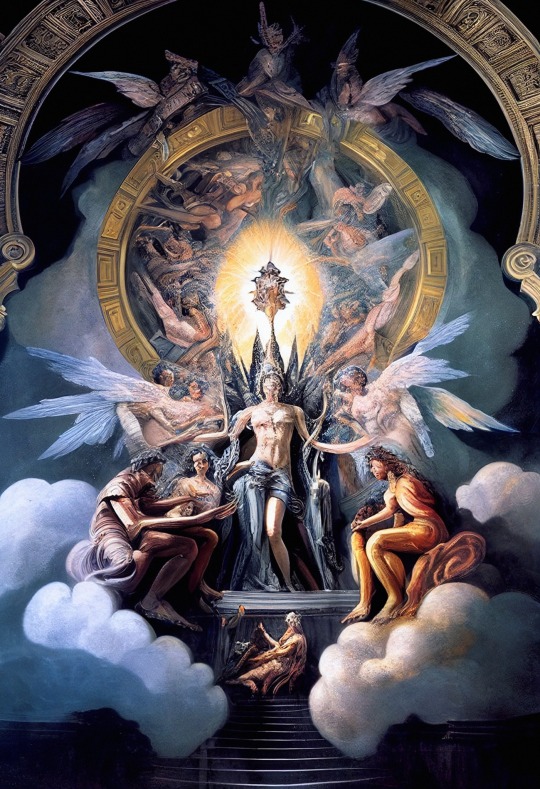
Orphic Hymn to Jupiter: Empower Your Jovial Prayers & Magic
Jupiter, known in traditional astrology as the Greater Benefic, would be an excellent place for many people to start building relationships with planetary spirits or beginning a devotional practice. The Renaissance magician-physician Marsilio Ficino advised as a general rule for people “to increase the influence of the Sun, of Jupiter, or of Venus.” Invocations, prayers, and offerings to a planetary spirit can help you attune to and come into rhythm with that planet. There are many ways to pray to or invoke a planetary spirit, including simply speaking from the heart, but a natural place to start is one of the most common and accessible prayers to Jupiter: The Orphic Hymn to Jupiter.
The Orphic Hymn to Jupiter
The Orphic Hymns are a collection of Hellenistic religious poems that were involved in the practices of Orphism, a mystery religion centered around the mythical figure Orpheus. The infamous magician Heinrich Cornelius Agrippa wrote that “nothing is more effective in natural magic” than the hymns of Orpheus.
The Orphic Hymn to Jupiter exemplifies one approach to planetary prayer, which is to regale the spirit with praise, listing many noble qualities and superlatives associated with that spirit. The traditional Orphic Hymn to Jupiter (Jove) reads as follows:
O Jove much-honored, Jove supremely great, to thee our holy rites we consecrate, Our prayers and expiations, king divine, for all things round thy head exalted shine. The earth is thine, and mountains swelling high, the sea profound, and all within the sky. Saturnian king, descending from above, magnanimous, commanding, sceptered Jove; All-parent, principle and end of all, whose power almighty, shakes this earthly ball; Even Nature trembles at thy mighty nod, loud-sounding, armed with lightning, thundering God. Source of abundance, purifying king, O various-formed from whom all natures spring; Propitious hear my prayer, give blameless health, with peace divine, and necessary wealth.
Throne of Jupiter by Talon Abraxas
23 notes
·
View notes
Text
The transition to the Renaissance and renaissance philosophy
The Transition to the Renaissance and Renaissance Philosophy
The Renaissance, a period that spanned roughly from the 14th to the 17th century, marked a profound transformation in European thought, culture, and society. This era, characterized by a revival of classical learning and a shift away from medieval scholasticism, laid the groundwork for modern philosophy and science. This article explores the transition to the Renaissance and the key philosophical developments that emerged during this transformative period.
The Transition to the Renaissance
Historical Context
The transition to the Renaissance was influenced by various factors, including the decline of feudalism, the rise of city-states, and the rediscovery of classical texts. The Black Death in the 14th century significantly altered the social landscape, leading to labor shortages and a questioning of traditional authority. As Europe began to recover, a renewed interest in the arts and sciences emerged, fueled by the wealth of the burgeoning merchant class and the patronage of powerful families, such as the Medici in Florence.
The fall of Constantinople in 1453 played a crucial role in this transition. The influx of Greek scholars into Italy brought with them ancient manuscripts and knowledge that had been preserved in the Byzantine Empire. This exchange of ideas catalyzed the revival of classical philosophy and literature, which became central to Renaissance thought.
Humanism: The Intellectual Movement
At the heart of the Renaissance was Humanism, an intellectual movement that emphasized the study of classical texts and the value of human experience. Humanists sought to reconcile ancient wisdom with contemporary life, advocating for a curriculum based on the studia humanitatis, which included grammar, rhetoric, history, poetry, and moral philosophy. Figures such as Petrarch, Erasmus, and Leonardo Bruni were instrumental in promoting this educational reform, emphasizing the importance of individual potential and critical thinking.
Humanism marked a departure from the medieval focus on theology and the afterlife, shifting attention towards human agency and the material world. This new perspective encouraged a more secular approach to knowledge, allowing for the exploration of diverse philosophical ideas and the questioning of established doctrines.
Renaissance Philosophy
Renaissance philosophy is characterized by a revival of interest in ancient Greek and Roman thought, particularly Platonism, Neoplatonism, Stoicism, and Epicureanism. This philosophical revival was not merely a return to classical ideas but involved reinterpretation and integration with contemporary thought.
Key Philosophical Developments
Platonism and Neoplatonism: The Renaissance saw a renewed interest in Platonic ideas, particularly through the works of philosophers like Marsilio Ficino. Ficino's translation of Plato's dialogues and his synthesis of Platonic thought with Christian theology laid the groundwork for a new understanding of the relationship between the divine and the human. Neoplatonism emphasized the importance of the soul's ascent towards the divine, influencing art, literature, and philosophy.
Aristotelianism: Despite the rise of Humanism, Aristotelian philosophy remained influential throughout the Renaissance. Many scholars continued to engage with Aristotelian ideas, particularly in the fields of natural philosophy and ethics. The integration of Aristotelian principles with emerging scientific inquiries contributed to the development of modern science.
Skepticism and Empiricism: The Renaissance also witnessed the emergence of skepticism, as thinkers like Michel de Montaigne questioned the certainty of knowledge. This skepticism paved the way for empirical approaches to understanding the world, emphasizing observation and experience as sources of knowledge. The shift towards empirical methods was a precursor to the scientific revolution of the 17th century.
Political Philosophy: The Renaissance produced significant contributions to political thought, particularly through the works of Niccolò Machiavelli. In his seminal work, The Prince, Machiavelli explored the nature of power and governance, advocating for a pragmatic approach to politics that focused on effectiveness rather than moral considerations. This departure from idealistic notions of governance marked a significant evolution in political philosophy.
Ethics and Morality: Renaissance philosophers also engaged with ethical questions, often drawing on classical sources. The exploration of virtue, happiness, and the good life became central themes, with thinkers like Erasmus promoting moral philosophy that emphasized the importance of character and virtue in personal conduct.
Conclusion
The transition to the Renaissance was a pivotal moment in European history, marked by a revival of classical learning and a profound shift in philosophical thought. Renaissance philosophy, characterized by its engagement with ancient texts and the exploration of human potential, laid the groundwork for modern philosophy and science. The interplay between humanism, classical thought, and emerging empirical methods fostered a rich intellectual environment that would shape the course of Western thought for centuries to come. As scholars and thinkers navigated this transformative period, they not only redefined the nature of knowledge but also reimagined the role of humanity in the world.
Citations: [1] https://mcallen.libguides.com/philosophy/renaissance [2] https://iep.utm.edu/renaissa/ [3] https://aeon.co/essays/there-was-no-such-thing-as-renaissance-philosophy [4] https://en.wikipedia.org/wiki/Renaissance_philosophy [5] https://www.rep.routledge.com/articles/overview/renaissance-philosophy/v-1 [6] https://www.britannica.com/topic/Western-philosophy/Renaissance-philosophy [7] https://courses.lumenlearning.com/suny-fmcc-hum140/chapter/3-12renaissance-philosophy-and-thought/ [8] https://en.wikipedia.org/wiki/Forensic_science
0 notes
Text
Abruzzo, Marsilio: "Campo lungo ha battuto il campo largo"
Il governatore confermato: “Schlein e Conte hanno parlato di barzellette come mia romanita'”source
View On WordPress
0 notes
Text
Anonymous asked: I don’t know if you caught King Charles III’s Christmas speech to the British nation but what did you think of it? I am a royalist but I always had my doubts about Charles and his championing of multi-faith harmony over his lack of Christian convictions (as opposed to the late Queen Elizabeth was a staunch Christian). Isn’t Charles just hastening the continued decline of the Christian heritage of Britain?
As it happens I did catch his Christmas broadcast as it’s very much part of the Christmas ritual in our home, like many other homes across Britain. This year it was very strange not to see the regal face of the late Queen. Her presence on television was very much part of the Christmas furniture as was the obligatory James Bond movie that often followed the broadcast. But there King Charles III was addressing the nation. It was perhaps the first time I truly realised that he was our king now - and I mean that as a compliment.
I’m afraid I’m not one of those who is convinced that Britain’s slide into Christian decline is perpetuated by King Charles III’s religious beliefs. When he delivered his Christmas speech to the nation, some were eager to read this into his words, just because he referenced other faiths other than Christianity. I understand the philosophical nonsense of squaring the multi-faith circle and worse how it can even dilute and undermine the distinctive and absolutist claims of non-relative religious movements so that they can be rendered increasingly irrelevant by an uncompromising secular rationalism. I understand all that. I just don’t buy it when it comes to King Charles III and his religious beliefs.
Of course before he became King, Charles’ view on religion, especially multi-faith beliefs, were always a source of alarm for some. He was accused of essentially showing sympathy for Perennialism - a school of thought which holds that there is some degree of truth in all the world’s traditional belief systems - and in doing so, Charles is guilty of undermining the exclusivity of Christianity and succumbing to a post-modern paradigm of cultural relativism. In holding this view he was seen by critics as heralding a world in which even the monarchy is too scared to defend its own values in the face of multiculturalism.
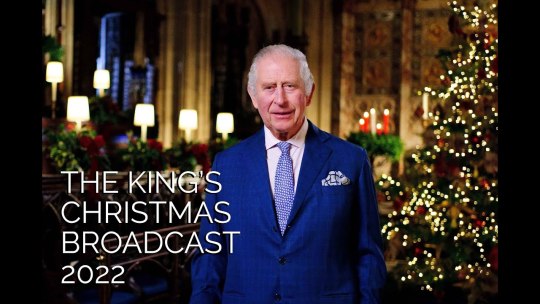
But listen carefully to the speech again and I struck by the reverence with which he spoke of his Christian faith. His emotive account of his visit to Bethlehem, where he “stood in silent reverence by the silver star that is inlaid on the floor and marks the place of our Lord Jesus Christ’s birth” is surely a welcome surprise in 2022, the first year in history where Christians are officially a minority in England and Wales. It is certainly not something one would expect from an apparently post-modern monarch indifferent towards the disenchantment of the country.
Still, instead of celebrating this, some remain cynical - the reason being that Charles, as well as praising the social and charitable contributions of the church, also praised those of synagogues, mosques, temples, and gurdwaras. This isn’t a slide into 21st Century relativism and simultaneously a compromise of his own Christian convictions, but a recognition of people of strong faith being good citizens in a country they love.

I think many critics underestimate King Charles’ own Christian convictions. I think he sincerely believes that there is one Light and one Truth in Christ. But it also dovetails with his soft Perennialist worldview in recognising the possibility for other faith traditions to also participate in that light and, perhaps, help to overcome the greater threat of secular modernity.
I’ve heard the argument from others that in fact Charles’ views on religion are remarkably similar to those of European Renaissance thinkers, who defended their appreciation of other faiths on traditional theological grounds. The 15th Century Italian Catholic priest Marsilio Ficino, for example, upheld the primacy of Christianity while also believing that other religions contained within them a glimmer of truth, the prisca theologia, and should be respected on this basis. For Ficino, this did not compromise his Catholicism; it simply showed that the love of God was universal, if perfected through Christ and Christ alone.
As it happens, other Renaissance thinkers saw this to be the ideal position for a monarch. For the 16th Century French political theorist Jean Bodin, the King should be the One above the Many, whose duty is to uphold the universal values shared by all people; to be the unity that transcends the multiplicity of sectarian difference. This entailed representing not only Christians of all denominations, but also Jews and Muslims. As an absolute monarchist, Bodin was deeply conservative by today’s standards, but even he saw it as perfectly acceptable for a King to honour subjects from religions other than his own.
So, as the argument goes, in living up to the ideals of Ficino and Bodin then Charles is some kind of Renaissance king. I’m not sure I completely convinced by that. But he is most certainly not a post-modern king. In many ways Charles is like his late mother in that he has a Christian faith - how strong is something I can’t determine, unlike the late Queen who was very devout and saw herself as a servant Queen serving her heavenly King. I am convinced Charles has Christian convictions and beliefs that are married to rituals of his royal identity.

In 1994, Charles triggered controversy when he said he would be defender of faith rather than Defender of the Faith, in a desire to reflect Britain’s religious diversity. There were suggestions that the coronation oath might be altered. In 2015, he clarified his position in an interview with BBC Radio 2, saying his views had been misinterpreted. He said: “As I tried to describe, I mind about the inclusion of other people’s faiths and their freedom to worship in this country. And it’s always seemed to me that, while at the same time being Defender of the Faith, you can also be protector of faiths.”
He pointed out that the Queen had said her role was “not to defend Anglicanism to the exclusion of other religions. Instead, the Church [of England] has a duty to protect the free practice of all faiths in this country. I think in that sense she was confirming what I was really trying to say - perhaps not very well - all those years ago.”
Now, as he formally ascends the throne at his coronation almost three decades after that controversy, most people would agree that Charles should champion the right to religious belief and practice of all his subjects, not just that of the dwindling number of people in the pews of Anglican churches.
G.K. Chesterton wrote that “the opponents of ritual attack it on the ground that it becomes formal and hollow. So it does. But ritual only becomes formal and hollow where men are not sufficiently ritualistic.” I think Charles is deeply steeped into royal rituals and traditions which are strongly rooted in the Christian history of these British isles. I’m sure you will see this at his coronation which will amplify his Christian convictions.
What do I mean by that?
In 1820, The Black Book, a radical critique of the corruption and power of the English Establishment, made this comment on royal ritual: “Pageantry and show, the parade of crowns and coronets, of gold keys, sticks, white wands and black rods; of ermine and lawn, maces and wigs, are ridiculous when men become enlightened, when they have learned that the real object of government is to confer the greatest happiness on the people at the least expense.” Forty years later, Lord Robert Cecil, the future third marquess of Salisbury, having watched Queen Victoria open parliament, wrote with scarcely more approval: Some nations have a gift for ceremonial. No poverty of means or absence of splendour inhibits them from making any pageant in which they take part both real and impressive. Everybody falls naturally into his proper place, throws himself without effort into the spirit of the little drama he is enacting, and instinctively represses all appearance of constraint or distracted attention.
As Sir David Cannadine, the great British historian, suggests, the elite's desire to temper the radical consequences of democracy was a crucial reason for their invention of so many royal rituals since the later nineteenth century. Indeed, for Cannadine, it is precisely the 'invention' and performance of royal rituals and Christian traditions, perfected at the end of the nineteenth and beginning of the twentieth century, which prevented the British monarchy from suffering the same fate as its Austrian, Prussian and German equivalents.

The Queen's coronation in 1953 was the first major international event to be broadcast on television, with an estimated 20.4 million viewers in the UK alone, 56% of the adult population. The coronation was the first media event seen by the majority of the population, and was for many their first experience of 'watching the box'. What people saw or were presented in the case of the British monarchy, were many references to its past by pointing out similarities between Elizabeth II and her famous predecessor Queen Victoria, by highlighting the longevity of rituals, or by implementing (seemingly old, but often invented) traditions in royal events like jubilees. In all of these cases, a diachronic genealogical link to the past is established in order to point to the institution's continuity, stability and anchorage in British history.
But Chesterton is onto something that has never really been talked about when we look what is behind the Christian symbology of rituals (real or invented).
Britain’s monarchy stands as the world’s only remaining state religious institution. The coronation is more than mainly a religious ceremony, as if that remaindered it for everyone not religious. It is a symbol among much else of the world’s oldest and only global narrative: God’s story. It goes all the way back to the crowning of Edgar by St. Dunstan in AD 973, drawing, it is said, an on even older Frankish ceremony. It takes place in Westminster Abbey, the national shrine. The oath is administered by the highest clergyman in the land. His office takes precedence even over the monarch himself. There is not just the formula “So help me God” repeated as does the U.S. president at the end of every secular statement; there is not simply an oath “upon my honour and integrity,” as in Turkey, or upon the honour of the nation, as in Ukraine.
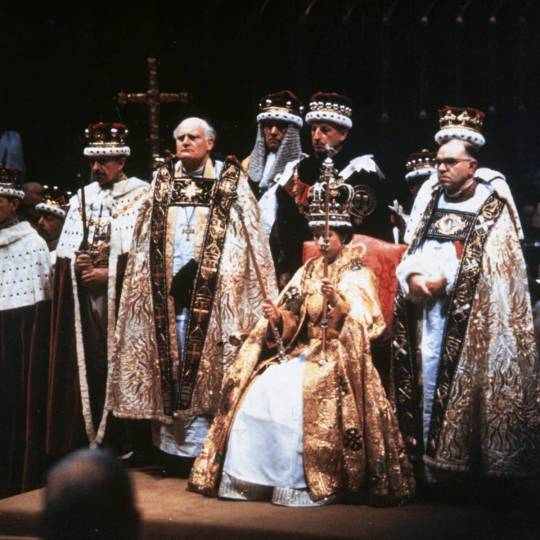
The new queen in 1953 was asked, “Will you to the utmost of your power maintain the laws of God and the true profession of the gospel?” And she, and now as Charles will, pledged to do this, kneeling at the altar of the greatest temple in the land, hand upon Bible; “the most valuable thing this world affords,” the priest intones. And of which the priest then adds:
Here is wisdom. This is the royal law. These are the lively oracles of God.
Then, in the even more amazing rite of unction that stretches in one unbroken line from the anointing of Solomon by Zadok the priest and Nathan the prophet in the Hebrew Bible, the king is anointed with oil under a gold awning in a ceremony of the utmost holiness. The archbishop hands him the symbols of his rule:
Receive this orb set under the cross, and remember that the whole world is subject to the power and empire of Christ our redeemer.
It is this that is the radioactive heart of Britain’s monarchy, and the secret of its strength. I think King Charles knows this. And so King Charles III will, I hope, defend faith in such a way that accounts for the universal and particular, all the while remaining committed to Christianity, the fabric of Britain’s history and heritage.
Both the monarchy and its rituals are together a protection against tyranny and a remedy for weakness. For, long forgotten by secular pundits, it models itself on the Christian belief that authority is what it is because it has been crucified; that only Christ the servant king is truly powerful, and because all are fallen, all can be restored only through him. King Charles III’s speech was a reminder of the eternal Light that will outlive the rise and fall of worldly civilisations; just what the nation needs to hear at Christmas.
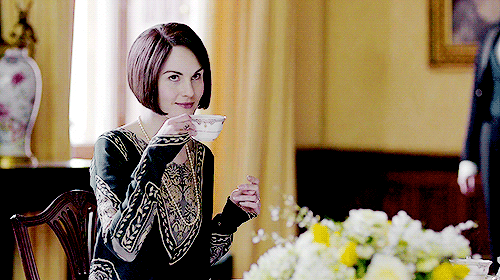
Thanks for your question.
#question#ask#king charles III#religion#christianity#christmas#heritage#tradition#multi-faith#britain#coronation#gk chesterton#perrrenialism#custom#society#queen elizabeth II#monarchy
51 notes
·
View notes
Text
☾✧゜BTS Numerology Chart | Heart's Desire: a peek into their relationships and career ☾✧
Disclaimer: Look, we know the disclaimer by now, although numerology is heavily reliant on maths, it's still not a definite way to define someone as they have a lot of other phases to them as human beings. I am diving a little into uncharted territory as I usually don't speak about their sexual relationships but know that the observations here are applicable to every other person with the same number so it's impersonal. With that being said, for entertainment purposes only. Note that this reading is based on their romanized names.
What is the Heart's Desire Number? based on the softer parts of the self, it shows the inner and deepest cravings that the soul needs to grow and evolve.
Kim Seokjin ☾✧゜
Heart's Desire Number: 11
So it's a Master number, we are already starting off strong.
Seokjin is bound to have incredible manifesting power.
He's magnetic and wise while holding a very broad outlook in life.
Very curious and intuitive
Masterful leader in situations
He's got a fear of being limited in any aspect of life
Can sometimes doubt his power and vision.
He's prone to have his own business so that he isn't told what to do.
Takes things at his own pace and likes to have fun.
Natural charmer but are we even surprised?
Innately intelligent
He's VERY selective when it comes to partners.
Only interested in someone who has a common outlook in life as well as being equally committed to personal growth.
Listen- this man knows exactly what he wants and that is copious amounts of truth and integrity in any relationship.
He's living on the fast lane of life
Fitness is important on his day to day.
Has a very VERY busy schedule that doesn't help him stay committed.
Good sense of humour
Has zero trouble attracting people.
While he's apparently not lacking in the whole having a lot of different partners department, he's not easily impressed.
Number also determines an ultimate destination of greatness
Will definitely leave a mark on humanity.
Min Yoongi ☾✧゜
Heart's Desire Number: 3
Has a smile that lights up the world
Highly magnetic, everyone seems drawn to him.
His greatest asset is his imagination
Has a strong calling to express himself through music
Has a contaging wit and charm that others find inspiring
He enjoys the spotlight but not in an attention seeking way
His soul urge is to light up those around him.
He does tend to doubt himself and be very wary of other people.
When it comes to relationships, he's a hopeless romantic
He'll pull all the stops for someone he loves.
Definitely not afraid to put himself out there and express his feelings, which leads him to feel rejected if said feeling aren't recirpocrated immediately.
Has a history of countless heartbreaks yet he rebounds quickly.
Never finds himself single for long.
He's most probably had quite some partners of different types
Not interested in people that fall at his feet
He's bound to have his own business
AND leave his mark on humanity.
Jung Hoseok ☾✧゜
Heart's Desire Number: 2
He's a man with deep empathy, intuition and finesse
He seeks to understand those around him more than be understood.
He's incredibly diplomatic.
He tends to disagree with alphatype personalities.
His soul urge is to cooperate rather than be told what to do.
LOVES turning uncomfortable situations into peaceful ones.
He's rarely in conflict with others.
This man knows right away when something is off
He's too empathic and caring that he often gives too much of himself to others.
He's more into commitment than he is to a single life.
Thrives in partnerships
No sacrifice is too great when it comes to someone he loves.
However his vulnerability is bound to cause him heartache.
He loves more openly and deeply than others.
A natural charmer
Bound to own his own business.
Living in the fast lane at this point in life
Likely to be extremely successful
He's probably learning a second language
Has had his fair share of different type of partners, but not in a playbloy type of way.
Kim Namjoon ☾✧゜
Heart's Desire Number: 22
We've got another master number.
He's got everything to be wildly successful
Intuitive, powerful, and practical
Has a strong calling to be a masterful builder and to create a legacy that will support generations to come.
Bound to work on something that involves a large number of people.
Has very high ideals but is very down to Earth
Tends to overestimate abilities and takes on tasks that he is not yet prepared to tackle just to please others.
In relationships, he is very practical
He values growth and companionship more than he does love itself.
He's perceptive and romantic nonetheless
Bound to be extremely successful
Has had plenty of different types of lovers
Not impressed at all by shallow people.
Park Jimin ☾✧゜
Heart's Desire Number: 1
He has incredible talent and creativity
Isn't afraid of taking risks
He's always honest and true to himself
Completely dislikes being micro-managed at work and in his personal life
Refuses to play second fiddle or give into the demands of others unless it is to avoid serious conflicts.
His soul urge is to be in the lead, not carried along behind it.
In relationships, he's the one in charge.
He tends to be the one that calls the shots
Since he's used to being in charge, he needs to make an effort so as not to come across as too uncompromising.
He has a deep need for independence so he's very careful with who he gives his attention to.
When his heart is open he is very loyal
He's bound to be extremely successful
Is living on the fast lane of life
Will own his own business
He's had a lot of different types of partners so far yet he's selective due to how he carries himself.
Kim Taehyung ☾✧゜
Heart's Desire Number: 9
He's an old soul
Has deep intuitive wisdom
People are naturally drawn to him
He's very appreciative and caring
He goes for altruistic matters rather than logic
He always wants everyone to benefit from situations.
He's willing to give regardless of the cost for him.
Has a strong moral sense and natural compassion.
He tends to be impressionable which might make others take advantage of him.
He's a very romantic person.
Incredibly compassionate and understanding
He can become quite impersonal or neglect his feelings when preoccupied with helping others.
Even though, he's more loving and present than most.
He's great with people.
He's bound to own his own business.
Bound to be extremely successful
Has had a fair share of partners of all types yet he's not attracted at all to shallow people
Jeon Jungkook ☾✧゜
Heart's Desire Number: 8
He's one to move on quickly
Has a long list of achievements
And an ability to achieve great goals
He's a natural leader and a great source of security for others.
Has a strong call to be in a position of power.
Gets easily frustrated with people who slack off or think small.
The embodiment of go big or go home.
In relationships, he has very VERY high standards
Due to him being as ambitious as he is, he tends to lack emotional flexibility and neglects romantic gestures
Fun and adventure are his things
Is able to excel in a lot of stuff
He's likely to own his own business
A natural charmer.
He's innately intelligent.
Bound to be extremely successful.
Fitness is a big thing in his life.
Has had quite some partners of different types yet not in a bad way.
Not interested in shallow people/ people that don't fulfill his standards in some way.
FINAL THOUGHTS
I'd say for the most part it seems consistent with things that come out of readings, some of their pointers are REALLY straightforward on them being meant to be on the path they are (we'll explore the life path number sometime later on) but it does seem to point to them being big and successful both on their own and as a group since their numbers seem to cooperate amazingly. It does look to me like they're meant to either take over HYBE or have their own company. The 'plenty of partners' wasn't much of a surprise, they're men in their mid-late twenties, handsome, on top of the world, it is just funny to see most of them having 'high standards' yet having a lot of partners, seems to me like those standards are more applicable or more strictly applicable to a deeper/ more committed relationship.
Sources: Marsilio Ficino and Hans Decoz texts
94 notes
·
View notes
Text

I want to know more about Antonia and her four daughters… Marsilio also leaves her more money in a later Item in the will
#he is most likely just being purely charitable#but it was a common practice for priests to claim they owed their housekeeper and her children money when they’re actually his kids#and it’s his way of looking out for them without ruffling feathers#I just … idk man I just look at that and go Huh. Interesting#Probably him being a good and charitable man because that’s who he was#but also#huh#marsilio ficino#Renaissance Florence#renaissance Italy#Marsilio blogging#Marsilio sourcing#also he was keen on ensuring illigitimate children of his brothers and nephews could inherit#which wasn’t always common practice
8 notes
·
View notes
Text
An Overview of Translation History: A Guide
During the history of translation, it has played a vital role in almost every aspect of humanity. Since primitive times, translators were now of great aid in the growth of languages, forming scholarships, and shaping national identities.
Numerous translators in the past have been addressed for their work, due in part to the lack of translators and similarly because what they translated made a vast impact on education, politics, religion, and other fields.

One of the most prominent was Saint Jerome, the supporter saint of translators, who decoded the Bible written in Greek and Hebrew into Latin, which became the certified version of the Bible used by Catholics.
Late Medieval to Early Renaissance
Gemistus Pletho (Plethon), a Byzantine researcher from Constantinople, went to Florence to restore the idea of Plato. He inclined Cosimo de Medici into founding the Platonic Academy, which was regulated by Marsilio Ficino, a scholar, and an Italian translator.
The Platonic Academy interpreted all the works of Plato, other works, and Plotinus’ Enneads’ works into Latin. Another major translation work during the 15th century is the language translation and free adoption by Thomas Mallory of ‘Le Morte d’Arthur,’ which consists of the tales of characters like Guinevere, Lancelot, Merlin, the Round Table, and King Arthur.
The rise of the west
The growth of the middle class and the advancement in the printing process during the 16th century further developed translation as the plea for new literary materials improved.
During this period, an English scholar called William Tyndale led a group to work on the primary Tudor translation of the New Testament in 1525.
One of his supporters finished translating the Old Testament, which was mass-produced in later years.
Transparency in Focus
In the latter part of this century, the standards of translation were faithfulness and transparency. Faithfulness means the scope of the translation’s accuracy in executing the source text into the target language while considering the features and context of the original.
Transparency in the translation means how close the text seems as if it was written in the target language while conforming to the target language’s grammar, syntax, and idiom and equating to idiomatic translation.
Start of the Industrial Revolution
Language translation services in this century are all about accuracy and style, with the translation policy focused on text. Because it is the Victorian era, coarse language was the exemption to the rule. Details in footnotes were also believed essential. Translators were meant to tell readers that the book or text they were relishing were translations of foreign examples.
19th Century influencers
The 19th century took several theories about translation. For Friedrich Schleiermacher of Germany, the translation can use two translation methods: foreignization or fidelity, which brings the reader to the writer, and domestication or transparency, which brings the writer to the readers.
Besides, the scholar and Chinese translator Yan Fu developed a three-facet translation theory in 1989, based on his wide-ranging skill in Chinese to English translation of social sciences documents. The theories are elegance, expressiveness, and faithfulness.
End of the 2nd millennium
Translation became more structured and prominent in the 20th century when reading the context of the written text became vital. Polish translator Aniela Zagórska, who rendered every work of Joseph Conrad into Polish, was given great instruction.
Joseph Conrad was her uncle, and Conrad observed translation as a skilled form that gives translators choices, which intended to interpret some of the text, on its place of just translating them.
The Present
Translation studies, which initially started in the latter part of the 20th century, is already an academic course today. It includes various subjects such as comparative literature, computer science, history, linguistics, philosophy, semiotics, and terminology.
It entails students choosing their strengths. When they specify, translators receive appropriate training either in legal, economic, technical, scientific, or literary translation.
Modern translators helped advance languages by borrowing terms and loanwords from a source language into a target language. The Internet and technology created a global market for language services, including the creation of localization services and translation software.
Evolving industry
Working as a translator unlocked new openings for bilingual people who obtain the required skills to be qualified translators. They learn to use language translation CAT tools and other memory tools to speed up the process of translating documents.
But the current situation is contrary to the status of translators from Ancient times until the primitive years. In the past, they accepted translators as authors, academics, researchers, and scholars but not anymore.
The Future
The future looks positive for the language translation services industry. Forecasts evaluate that it’ll turn out to be US$56.18 by 2020. Assume more changes in the supply methods of translations.
· With a maximum number of companies helping international clients, the need for effective and fast communication increases. Several translation companies will be presenting a full set of translations to meet the burdens of the market.
· There will be more calls for non-English languages.
· Progress in computer-aided productivity tools and CAT tools will lower the cost of translation.
Wrapping Up
It is difficult to ignore the surge in the use of machines to aid the translation process. But they are not dangerous to human translators. Relatively, they help enhance the work of translators. It’ll permit them to emphasize the actual translation of a document.
Confirm that you are getting the perfect translation by working with a qualified language translation service agency like Acadestudio.
If you interested in this type services please click here : https://www.acadestudio.com .
2 notes
·
View notes
Photo
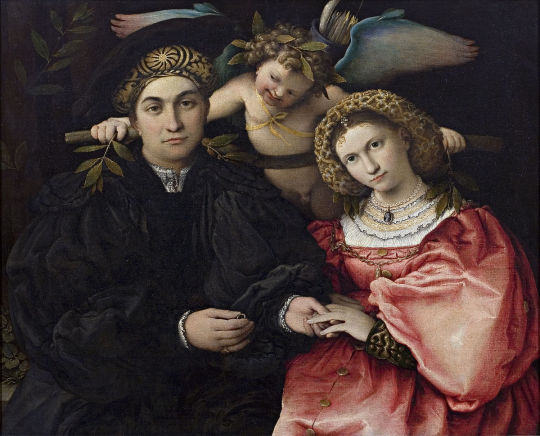
“Portrait of Marsilio Cassotti and His Bride Faustina” by Lorenzo Lotto (1523)
source: https://it.wikipedia.org/wiki/Ritratto_di_Marsilio_Cassotti_e_della_sua_sposa_Faustina
6 notes
·
View notes
Text
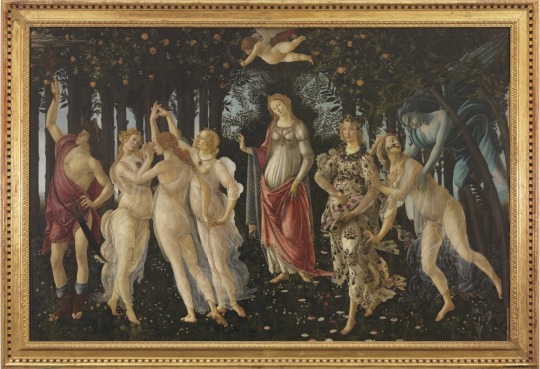
ICONOGRAPHY II: Botticelli’s Primavera
La Primavera is a modern title of convenience given to Botticelli’s picture, painted around 1478/80, of Venus standing in an orange grove with 8 other figures also drawn from classical mythology. The seasonal emphasis implied by that title is confirmed by the depiction of the transformation of Chloris, pursued by Zephyr, into Flora; by the figure of Mercury dispelling the clouds; and flower-strewn verdure. Vasari’s statement that the painting shows “Venere che le grazie la fioriscono, dinotando la primavera,” seemingly explains the relationship of Venus and the Three Graces to the vernal theme.
The painting is therefore not an illustration of a passage from an ancient text. Rather, figures and incidents from classical poetry and mythology have been lifted from their original contexts and grouped together to form a quattrocento allegory of Spring. Gombrich phrases this in more art historical terms when he affirms “the hypothesis that Bottcelli’s mythologies are not illustrations of existing literary passages, but that they are based on “programmes” drawn up ad hoc by humanists.”
However, as Gombrich also states in aside, Vasari’s description of “the Three Graces decking Venus with flowers” is inaccurate. The Graces dance, while Venus’ either directs the dance or keeps musical time. Shorn of its floral component, this group of figures cannot be said to “denote Spring,” and the hypothetical allegory of Spring collapses due to the lack of participation of nearly half of the painting’s figures. The allegory of Spring also fails to obtain if the actions of Mercury are interpreted not as the ending of bad winter weather, but applying the symbol and intrument of peace, the caduceus, to the clouds of war or civic dissension.
Reduced to the Flora group and a flowery ground, the allegory of spring would have to compete with one or two other allegories of uncertain meaning. It is unlikely that one of the eminent humanists employed by the Medici would have devised a disjunctive iconographic programme for a major artistic commission or have employed the machinery of allegory to signify a simple seasonal concept. Spring, therefore, is probably not the primary meaning of the picture.
Since Aby Warburg’s dissertation in Botticelli’s Primavera and Birth of Venus, scholars had accepted the poetry of Poliziano as the source of the picture’s iconography. Gombrich argued, however, that a letter from Marsilio Ficino to his student, Lorenzo di Pierfrancesco de’ Medici, provided if not a direct source for the picture’s iconographic program, then a particular, documented set of circumstances that suggest how it was intended to be interpreted. In his letter exhorting his 14-year old pupil to conduct him life virtuously, Ficino constructs an allegory consisting of pagan gods who represent virtues or qualities. For example, Jupiter is: the law, Mercury is reason, Mars speed, and Saturn slowness. Venus personifies not love, but humanitas, the Ciceronian ideal of an eloquent, urbane, cultured mode of existence emulated by the Florentine bankers.
Due to its wholly unconventional nature, Ficino’s alleogry required not only a detailed written exposition, but also the assistance of two other humanists who were asked by Ficino to reiterate and explicate it for his young pupil. Ficino also explains to his colleagues that visualizing his moral system as pagan deities will make the lesson more vivid and memorable. These efforts to instill in the mind of Lorenzo an understanding of Venus as humanitas takes place at exactly the moment when Botticelli’s picture of Venus was commissioned to decorate Lorenzo’s new residence. Gombrich argues that the young Lorenzo’s understanding of the painting would have been influenced by Ficino’s eccentric conception of Venus. Furthermore, Ficino and Botticelli were both members of the Neoplatonic circle of Lorenzo il Magnifico and both were employed by Lorenzo di Pierfrancesco. Given these circumstances, it seems likely that Ficino devised the iconography of the Primavera. The picture could therefore be understood as a collaborative effort by Ficino and Botticelli to instill in the younger Lorenzo Neoplatonically-inflected humanistic values that would inspire him to emulate the enlightened patronage of his uncle.
Edgar Wind strenuously criticizes Gombrich’s article in his discussion of the Primavera.
Ersnt Gombrich, “Botticelli’s Mythologies: A Study in the Neoplatonic Symbolism of his Circle,” Journal of the Warburg and Courtauld Institutes 8 (1945), 7-60.
Aby Warburg, Sandro Botticellis Geburt der Venus und Frühling: Eine Untersuchung über die Vorstellungen von der Antike in der italienischen Frührenaissance (Strasbourg, 1891).
Edgar Wind, Pagan Mysteries of the Renaissance (New York, 1958).
#italian painting - 15thc.#sandro botticelli#renaissance art#primavera#quattrocento#ernst gombrich#aby warburg#neoplatonism
32 notes
·
View notes
Text
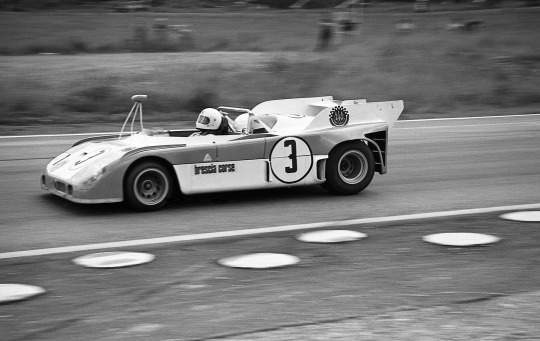
Marsilio Pasotti 'PAM' (Scuderia Brescia Corse - Alfa Romeo T33!TT!3 #11572-002) 1000 km de Zeltweg / Österreichring 1973. © Walter C. Harbers III. - source Carros e Pilotos.
13 notes
·
View notes
Text
O, Sun! purging all men's hearts with all your flames, do you wish so very much to be inaccessible to any mortal when, in fact, you are of all things most accessible to everyone? O, Sun! Source of Justice! Sun! Model of Generosity! As urgently as you incite me to seek you out, so shine back on me; with just such brilliance, with just such healing. Have I perhaps, dared to raise eyes that are too impure to the purest light?
Marsilio Ficino
16 notes
·
View notes
Text
Art History’s Iconic Depictions of Dreams, from the Renaissance to Surrealism
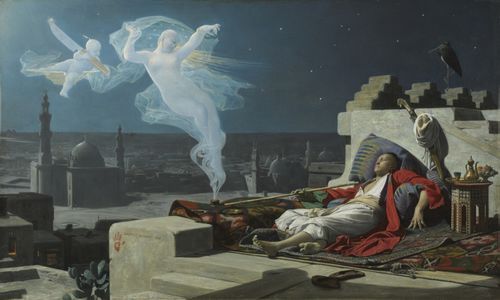
Jean Lecomte du Nouÿ, A Eunuch’s Dream, 1874. Courtesy of the Cleveland Museum of Art.
“When we fall asleep, where do we go?” This was the question looming over the long line of teenage girls who recently waited impatiently outside the Billie Eilish merch pop-up in Chinatown. The pop star didn’t invent this question. Philosophers, poets, and psychoanalysts have rhapsodized about the answer for centuries. It’s visual artists, though, who have, again and again, sought to show the impossible—to imagine, in pictures of sleeping subjects, the unseen places we go when we dream. From Godly visions to fantasies to nightmares, the representations of dreams in art have drastically changed since the Middle Ages.
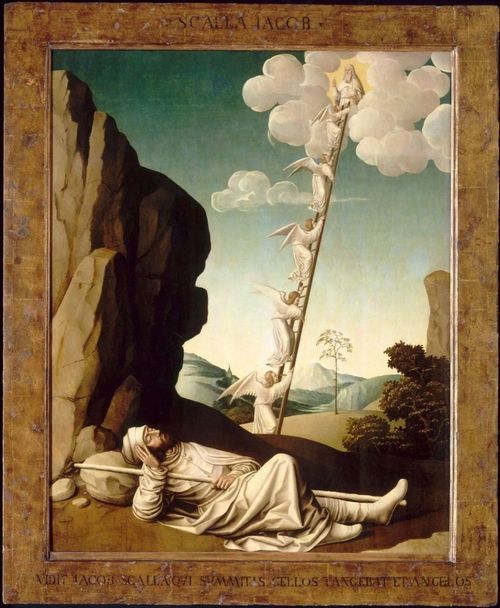
Nicolas Dipre, The dream of Jacob, ca. 1500. Image via Wikimedia Commons.
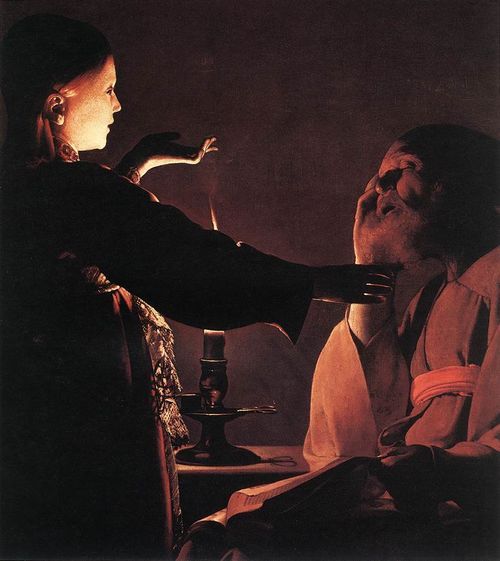
Georges de la Tour, Dream of St. Joseph, ca. 1600. Image via Wikimedia Commons.
In the Renaissance, as artists and Humanists turned to the writings and art of antiquity, they discovered the ancient philosophers like Hippocrates and Aristotle had been tantalized by the subject of dreams. The 15th-century Florentine philosopher Marsilio Ficino, in particular, took up the task of interpreting the meaning of dreams. His concept of vacatio animae posits that while sleeping, the soul can be freed from the corporeal restraints of the body and achieve a higher, spiritual state.
In art, this spiritual state often took the form of a dozing soul caught in a religious moral dilemma. But dreams also allowed Renaissance artists to heroize the creative imagination and play with sensual, pagan scenes. The Venetian painter Lorenzo Lotto’s Sleeping Apollo and the Muses with Fame (ca. 1549) shows the naked deity napping in an idyllic glade. An angel flying overhead surveys the heaps of discarded clothes and musical instruments, while in the distance, the Muses—reveric stand-ins for the creative imagination—perform an uninhibited dance.
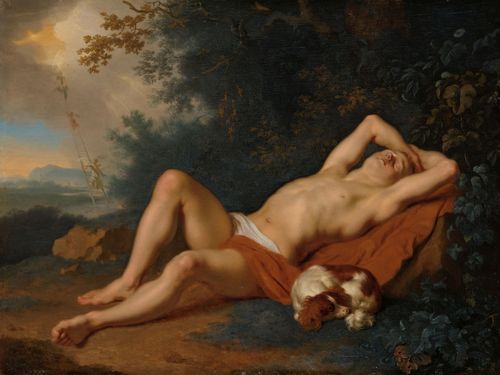
Ary de Vois, Jacob’s Dream, 1660–80. Courtesy of the Rijksmuseum.
Yet it was the Biblical dream—a communication from God—that artists were most often called upon to represent. The Old Testament stories of Jacob’s ladder and Joseph’s interpretation of Pharaoh’s dream were popular subjects. In both narratives, their dreams become important catalysts for change.
The dream of Jacob (ca. 1500), an oil-on-panel work by Nicolas Dipre, foregrounds Jacob, dressed ethereally in white, reclining outdoors with his head resting on a rock. His prophetic dream, in which angels mount a ladder to heaven, appears tangibly in the landscape behind his enclave. Jacob’s eyes may be closed, but his sight, the painting suggests, is clear.
Divine visions remained a popular challenge for centuries of Western artists, who imbued the well-worn stories with ulterior meanings. Ary de Vois’s version of Jacob’s dream (1660–80) is pointedly sensual. Jacob, nude save for a strategically placed bit of cloth, languorously stretches out on a patch of grass, his idealized body on full display. The ladder and angels appear far in the background, a decidedly less prominent focus of the picture compared with Dipre’s work. Here, Jacob’s vision from God is nearly ecstatic, offering pleasure to the sleeping figure much like Bernini’s famously erotic St. Teresa in Ecstasy (1647–52).
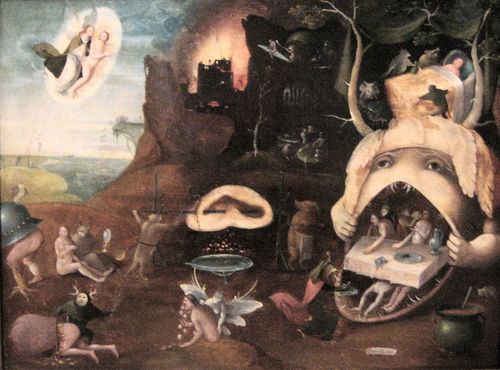
Followers of Hieronymous Bosch, The Vision of Tundale, ca. 1520–30. Image via Wikimedia Commons.
The stuff of nightmares was of little interest to the Italian or French Renaissance artists, who favored neo-Platonic ideals of beauty—until they encountered the disturbing fantasies of northern painters like Hieronymus Bosch. The Vision of Tundale (ca. 1520–30), attributed to Bosch’s followers, is a typically hallucinatory, “Boschian” scene. Inspired by the medieval poem “The Vision of Knight Tondal,” in which an errant knight dreams of his moral redemption after a vision of Hell, the painting depicts a spectacular and grotesque hellscape populated by monstrous creatures and graphic details. The work also takes on the idea of the nightmare as a phenomenon that is visited upon the living as a warning to repent for.Indeed, in the lower left-hand corner, the sleeping sinner Tondal is seen experiencing the nightmare firsthand.
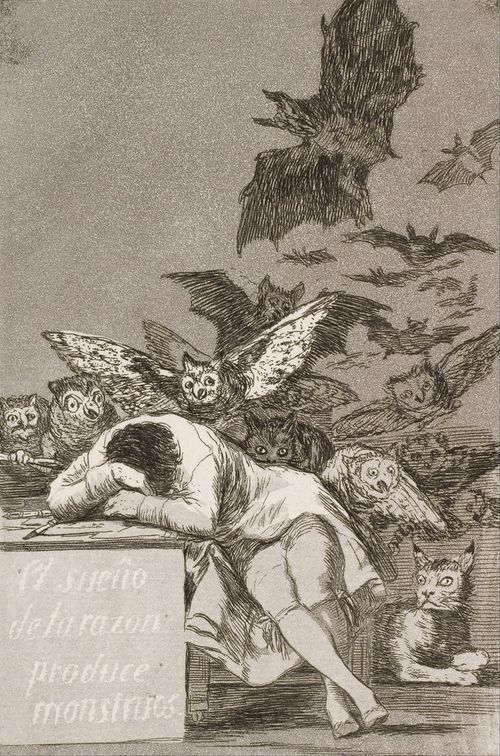
The Sleep of Reason Produces Monsters, No. 43 from Los Caprichos (The Caprices), 1796-1798. Francisco de Goya Nelson-Atkins Museum of Art, Kansas City, Missouri
Although the strictures of morality remain intact in The Vision of Tondal, when we slumber, the picture seems to suggest, reason sleeps too. Enlightenment-era artists made political statements about the irrationality exemplified by the nightmare. Francisco de Goya’s The Sleep of Reason Produces Monsters (1799) from his biting “Los Caprichos” series, employs the bad dream to criticize contemporary Spanish society, particularly pre-Enlightenment practices and superstitions the artist felt held the country back from modernizing. The central figure’s apparently peaceful sleep is interrupted, for the viewer at least, by the predatory creatures—associated, in Spanish folklore, with evil—that besiege him. Without the Enlightenment value of Reason, Goya forcefully asserts, evil wins.
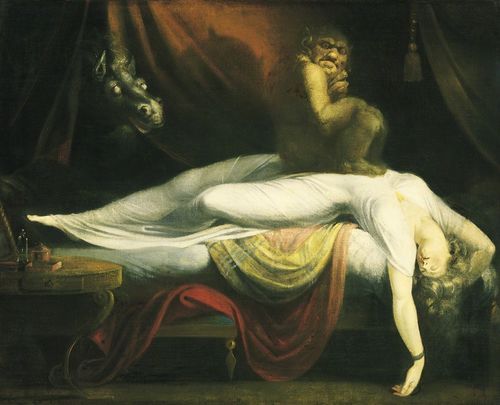
The Nightmare, 1781. Henry Fuseli The Detroit Institute of Arts, Detroit
Henry Fuseli’s famous Nightmare (1781) from around the same time would seem to suggest a similar narrative but is unusual in that it lacks a moral component, or even a literary, biblical, or art-historical precedent. The invented scene shows a woman in white stretched across her bed. A frightening incubus figure crouches on her chest while a horse with flared nostrils pokes its dark head out from behind a curtain. The work’s mysterious intentions and frightening imagery shocked audiences when it debuted, and seems to fall less in line with the “Age of Reason” than the ideals of Romanticism, in which European art and literature began to place value not on moral logic but emotion and spirituality. Some scholars today see the work as a prefiguration of Sigmund Freud’s psychoanalytic theories; Freud reportedly had a reproduction of the painting in his Vienna apartment.
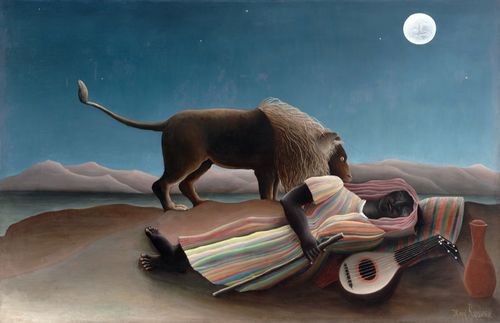
Henri Rousseau, The Sleeping Gypsy, 1897. Photo by VCG Wilson/Corbis via Getty Images
Before Freud, however, in the 19th century, artists involved with the Symbolist movement developed novel means to express subjective psychological and spiritual realities through the landscape of dreams. Their subject matter features heady mixes of fantasy, eroticism, the occult, and death, often to puzzling effect. What is the meaning behind Henri Rousseau’s The Sleeping Gypsy (1897)? Is the lion that licks the sleeping woman’s face a product of her dream or a terror of reality? Is the woman really sleeping in the desert at all, or is the whole picture a dream?
When Freud did publish his theories on dreams and the unconscious, the effect on art was immediate. In the 20th century, dreams became primary source material for the Surrealists, who sought to transcend the constraints of rationality—and the oppressive societal rules that had led mankind to the First World War. The unconscious became a creative tool that contained unexpected meanings and a window onto one’s secret, inner self.
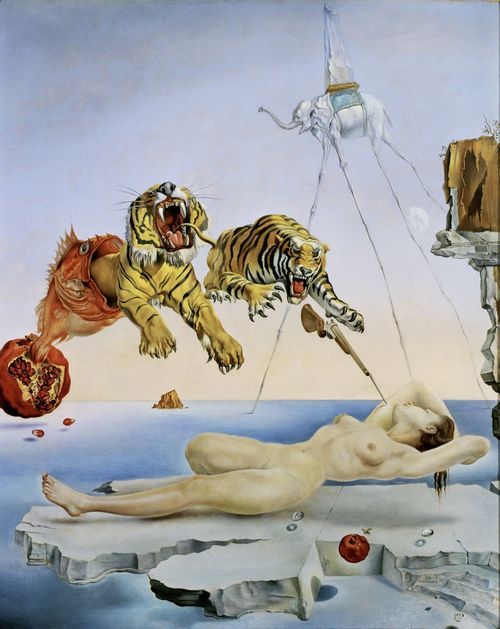
Dream caused by the Flight of a Bee around a Pomegranate a Second before Waking up, 1944. Salvador Dalí Museo Thyssen-Bornemisza, Madrid
Salvador Dalí interpreted dreams in his paintings in myriad ways, but it’s his 1944 work Dream Caused by the Flight of a Bee around a Pomegranate a Second before Waking, that takes on both the act of dreaming and its results in the same picture. The artist’s wife and muse, Gala, sleeps nude on a rock formation coming out of the sea. Gala’s dream manifests in the top half of the canvas, where two tigers and a rifle leap toward the resting figure from the mouth of a fish, which in turn emerges from a bursting pomegranate. As the title suggests, the onslaught of the dream will wake her moments later.
When we fall asleep, where do we go? Dalí, the Surrealists, and their artistic forebears understood the interpretive possibility of dreams as avenues for self-exploration. More importantly, they took full advantage of that question, relishing the creative freedom of the imaginative dreamscape.
from Artsy News
3 notes
·
View notes
Text
Regionali in Abruzzo, il rieletto presidente Marsilio parla di risultato storico
“I cittadini ci hanno dato fiducia. L’importante è la centralità dell’Abruzzo che vuol dire portare le risorse necessarie”source
View On WordPress
0 notes